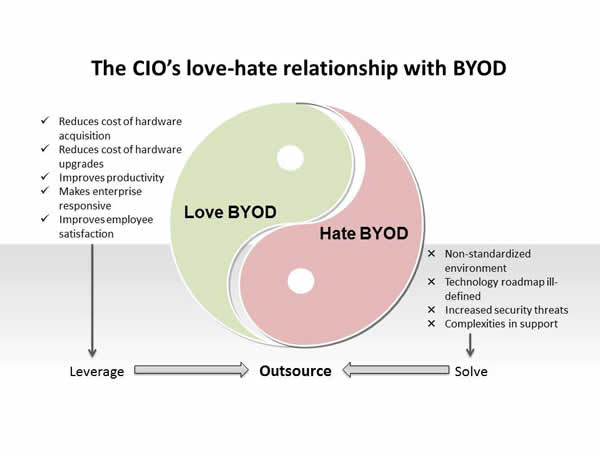 Are you at work? Check the mobile phone you are using. If you are in the Europe, Middle East and Africa (EMEA) region, chances are your company has allowed you to bring your own smart phone to work. The results of a recent survey of the region released by Aruba Networks (NASDAQ: ARUN) suggests that 69% of the organizations in the region have adopted some form of Bring Your Own Device (BYOD)[i]. In research revealed in early September by Global Information, Inc., 65% of global enterprises will allow at least limited BYOD by the end of 2012 and only 11% have no plan to. Does this reflect a global trend? Is there consensus on outsourcing most aspects of an enterprise?s BYOD adoption to improve chances of success and?more importantly?bring sanity to the enterprise mobility strategy?
Are you at work? Check the mobile phone you are using. If you are in the Europe, Middle East and Africa (EMEA) region, chances are your company has allowed you to bring your own smart phone to work. The results of a recent survey of the region released by Aruba Networks (NASDAQ: ARUN) suggests that 69% of the organizations in the region have adopted some form of Bring Your Own Device (BYOD)[i]. In research revealed in early September by Global Information, Inc., 65% of global enterprises will allow at least limited BYOD by the end of 2012 and only 11% have no plan to. Does this reflect a global trend? Is there consensus on outsourcing most aspects of an enterprise?s BYOD adoption to improve chances of success and?more importantly?bring sanity to the enterprise mobility strategy?
Enterprises have been wary, but not sluggish, in their response to the BYOD trend driven by the consumerization of technology. There are a number of reasons for enterprises to adopt BYOD. To begin with, it reduces the cost of hardware acquisition and regular upgrades. And second, it improves productivity and makes the enterprise more responsive. These are two reasons CIOs love the trend. But they hate it equally because of the complexities in evolving and implementing a sound strategy around BYOD adoption.
One of the ways to manage the complexity and bring down the pain of BYOD adoption is to outsource the complete process, along with strategy, plan, implementation, onboarding users, support and maintenance. Along the way, outsourcing also improves the ability to build an innovative app ecosystem that is robust, improves employee satisfaction, and delivers enhanced ROI on investments made in mobility.
Top Four Reasons to Outsource the BYOD Initiative
- Technological complexity: IT departments love standardization, and mobile technology thrives on evolution and change. No one can accurately predict which will be the dominant operating systems and form factors for mobile devices two years from now (or even 12 months from now). It is difficult for IT to align itself with the needs of mobility. Rather than get stressed, IT should look at outsourcing.
- Security: Managing security on mobile networks is complex and requires instant responses. For example, if a mobile device is lost or stolen, enterprise data could be compromised. Should an enterprise ensure it has legal permissions to remotely lock devices that are ?missing? but essentially belong to the employee in order to secure enterprise data? Or should all data be encrypted? Or should access to the data be defined based on networks? These are sticky questions best left to external experts to examine and create a response to.
- Device and app usage: As the number of employees bringing their devices grows, networks will need to be continuously monitored for device usage. A user may bring in two or more device to work. Which one has the permissions to log into the corporate network? Device registration and monitoring of applications will become critical. These will need to be assessed for policy compliance with each cycle of device and app change.
- Support: When an app changes, how does IT ensure that every user has the new version installed? Today?s regulatory requirements mean that lapses in conformance can prove to be expensive. How will IT manage to support users who are mostly remote even for simple things like changing passwords or upgrading the apps on their devices?
One of the ways to efficiently manage a BYOD roll out is to assess and implement an innovative Mobile Device Management (MDM) application and system. Since the issues involved in selecting the right MDM application can be complex and need to address end-point security, data backup, data encryption, role-based app access, restricted network access, device compliance, device monitoring, auto-freezing device capabilities such as cameras and recorders in certain environments, data and network security, etc., it is best to be innovative and outsource the assessment and implementation. Given the uncertainty involved in mobile usage and application growth as well as compliance requirements, outsourcing can be a comprehensive solution. The CIO then doesn?t have to worry about the selection of MDM applications. Instead, it becomes the outsourcer?s problem to provide capabilities and services based on changing enterprise needs.
When considering a provider to fast track your BYOD initiative using MDM applications, large enterprise should prioritize the following with their outsourcing partner:
- Setting appropriate policies and processes for devices, networks, and applications and geographies
- Remote device configuration, monitoring and management
- Enterprise application, data and network protection/ isolation
- Multi-platform capabilities
- Multi-platform support
- Audit and reporting capabilities
- Flexibility to integrate with future mobile systems
Success in rolling out the BYOD initiative depends on a sound strategy and the outsourced partner?s capability. But it is equally dependent on the ability of the organization to be innovative and back the initiative with budgets and periodic reassessment of strategy based on business and technology changes.
Category: Articles, IT infrastructure & applications
smokey robinson pulmonary embolism packages camila alves albrecht durer dan marino david lee roth
No comments:
Post a Comment
Note: Only a member of this blog may post a comment.